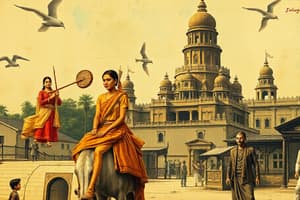Podcast
Questions and Answers
What was the primary administrative structure used by the Ahom Kingdom?
What was the primary administrative structure used by the Ahom Kingdom?
- Oligarchy
- System of land grants (correct)
- Meritocracy
- Feudal System
Which cultural revival significantly influenced Assamese literature in the late 19th century?
Which cultural revival significantly influenced Assamese literature in the late 19th century?
- Cultural Movements (correct)
- British Victorian Literature
- Sanskrit Revival
- Indian Nationalism
Who established the Ahom Kingdom in the 13th century?
Who established the Ahom Kingdom in the 13th century?
- Rudra Singha
- Bhaskar Varman
- Sukaphaa (correct)
- Gaurinath
What significant change occurred after the British invasion in 1826?
What significant change occurred after the British invasion in 1826?
During whose reign did the Ahom Kingdom successfully resist Mughal invasions?
During whose reign did the Ahom Kingdom successfully resist Mughal invasions?
What has been a significant aspect of the modern era in Assam?
What has been a significant aspect of the modern era in Assam?
Which of the following festivals is traditionally associated with Assamese culture?
Which of the following festivals is traditionally associated with Assamese culture?
What was one of the major impacts of colonial rule in Assam?
What was one of the major impacts of colonial rule in Assam?
What issues has Assam faced after becoming a part of India in 1947?
What issues has Assam faced after becoming a part of India in 1947?
Which smaller states were formed from Assam's territory?
Which smaller states were formed from Assam's territory?
Study Notes
Early History
- Ancient Civilization: Inhabited since the Neolithic era; evidence of settlements in the region.
- Cultural Influences: Mixture of indigenous tribes, including the Ahoms, Bodos, and various ethnic groups.
- Historical texts: Mention in ancient texts like the Mahabharata and the Puranas.
Ahom Kingdom (13th to 19th Century)
- Foundation: Established in the 13th century by Sukaphaa; significant area of influence.
- Administration: Developed a complex government structure; used a system of land grants.
- Military Power: Successfully resisted several invasions from the Mughals, particularly during the reign of Rudra Singha.
Colonial Period
- British Invasion: Faced several wars with the British; annexed in 1826 after the Treaty of Yandaboo.
- Impact of Colonial Rule: Introduction of tea plantations and railways; significant social and economic changes.
- Cultural Movements: Revival of Assamese literature and culture during the late 19th century influenced by reformers.
Post-Independence Period
- State Formation: Assam became a part of India in 1947; faced issues of identity and ethnic diversity.
- Ethnic Conflicts: Tensions between different ethnic groups over resources and political representation.
- Insurgency: Rise of separatist movements since the 1980s demanding greater autonomy and recognition.
Modern Era
- Economic Development: Growth of the oil and tea industries; emphasis on tourism and cultural heritage.
- Political Landscape: Continued struggles for identity and rights; formation of smaller states from Assam, such as Arunachal Pradesh, Nagaland, and others.
- Cultural Heritage: Rich traditions in music, dance (Bihu, Sattriya), and festivals that reflect its diverse population.
Early History
- Inhabited since the Neolithic era.
- Mix of indigenous tribes including the Ahoms, Bodos, and various ethnic groups.
- Mentioned in ancient texts including the Mahabharata and the Puranas.
Ahom Kingdom (13th to 19th Century)
- Founded in the 13th century by Sukaphaa.
- Developed a complex government structure with a system of land grants.
- Successfully resisted several invasions from the Mughals, notably during the reign of Rudra Singha.
Colonial Period
- Annexed by the British in 1826 after the Treaty of Yandaboo, following several wars.
- Introduction of tea plantations and railways.
- Late 19th century saw a cultural revival of Assamese literature and culture led by reformers.
Post-Independence Period
- Became a part of India in 1947.
- Faced issues of identity and ethnic diversity.
- Tensions arose between different ethnic groups due to resource allocation and political representation.
- Separatist movements demanding greater autonomy and recognition emerged in the 1980s.
Modern Era
- Growth of oil and tea industries, with focus on tourism and cultural heritage.
- Continued struggles for identity and rights, leading to the formation of smaller states from Assam, such as Arunachal Pradesh, Nagaland, etc.
- Rich traditions in music, dance (Bihu, Sattriya), and festivals reflect the diverse population.
Studying That Suits You
Use AI to generate personalized quizzes and flashcards to suit your learning preferences.
Description
Explore the rich history of Assam from its ancient civilization to the colonial period. This quiz covers key events, cultural influences, and the significant impact of the Ahom Kingdom. Test your knowledge on the historical texts, battles, and changes brought by colonial rule.



